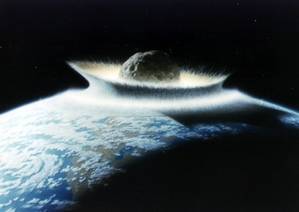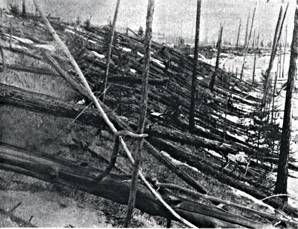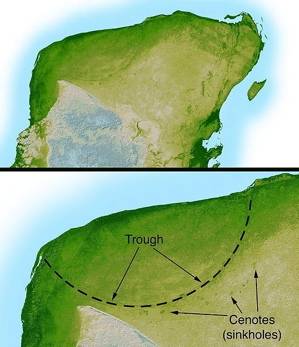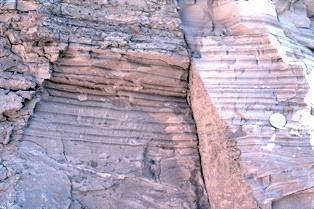Interesting facts about Earth
|
|

|
| A 500-km asteroid impact |

|
|
The Tunguska Fireball: Aftermath |

|
| Chicxulub crater |
There are many interesting facts about Earth with a bearing on biology. For example, the fact that asteroids have repeatedly impacted here over geological time — the larger ones have been the cause of mass extinctions.
Small ones — five to ten meters wide — enter Earth's atmosphere about once a year. But even these relatively small intruders release about the same amount of energy during entry as did the atomic bomb dropped on Hiroshima (most explode harmlessly in the upper atmosphere and are almost completely vaporized before hitting the ground).
In 1908, a large meteoroid or comet fragment, probably with a diameter of over 50 meters, burst over uninhabited forest in the Tunguska valley of central Siberia (see map >>) at an altitude of 5–10 kilometers (3–6 miles). This explosion, known as the Tunguska event, is estimated to have been 1,000 times as powerful as the Hiroshima blast. It scorched and flattened the forest to a distance of 50 kilometers (30 miles) and knocked down horses as far as 375 miles away. Such objects probably hit the Earth about once every 1000 years (Monastersky 1997).
But every 500,000 years or so an asteroid with a diameter of one kilometer (0.62 miles) or more collides with our planet. Even bigger impacts involving 5-km objects take place about once every ten million years.
The most recent known impact of this larger size occurred 65 million years ago, off the coast of Mexico's Yucatán Peninsula near the modern-day town of Chicxulub (/"tshook-SHOO-loob"/). The Chicxulub crater is 180 kilometers (110 mi) in diameter. The explosion released by the impact was equivalent to detonating 2 million hydrogen bombs simulataneously. It is now generally accepted that the Chicxulub event was the main cause of the Cretaceous-Tertiary (K-T) extinction of the dinosaurs (but see the discussion of the dinosaur extinction on this website >>).
So the history of geological and evolutionary change on this planet has been a mixture of gradual change and catastrophe. A 500-km asteroid hitting the Earth, such as that shown in the artist's rendering at the top of this page, would virtually sterilize the planet and start evolution over again at square one.

|
| An outcrop containing Pleistocene-aged varves (Enlarged image) |
Another interesting Earth fact is that its rotation speed is gradually slowing (Stokes 1982). We know this because some organisms preserved in the fossil record, such as corals and mollusks, lay down a daily layer of material. Many of the same organisms also show an annual variation in growth rate that allows geologists to count the number of daily layers in an annual cycle of growth. This translates directly into the number of days in a year at the time that the organism was alive. Many organisms, such as corals, also show a pattern reflecting lunar cycles. These cyclical patterns in the fossil record are called varves.
On the basis of such data, the number of days in a year has been determined for various points of time in the geological past. For example, about 420 million years ago (during the Silurian Period) there were 420 days in a year; 300 million years ago in the Carboniferous (359-299 mya) there were 390 days per year; 80 million years ago (in the Cretaceous (145.5-65.5 mya) there were 370. Today we have 365.2524 days in a year (but our years are still shortening — at the rate of about one day every 16 million years — the world won't stop turning anytime soon.
Another of the interesting facts about Earth is its great age. How old is Earth? Expert opinion estimates about 4.54 billion years (Dalrymple 2001). However, this is not known with certainty since no terrestrial materials have been shown to be that old. The oldest terrestrial minerals that have been reliably dated are zircon crystals from the Jack Hills of Western Australia. They are at least 4.4 billion years old. So it's safe to say that the Earth is at least that old. How much older? No one can say for sure.
It is believed that the Earth was initially far too hot to support life. However, the earliest traces of life are fossil bacterial colonies ("stromatolites"), probably of cyanobacteria, dating to about 3.9 billion years ago. This is some 500 million years later than the earliest known terrestrial minerals. It is unknown whether life first arose on earth or arrived from elsewhere — perhaps in the form of bacteria embedded in an icy meteorite.
During the vast stretches of time that it has existed, the temperature of the Earth has varied widely. Today only 71 percent of the Earth's surface is water. However, during warm periods in the past, such as the Cretaceous Period, oceans covered a much larger percentage of the globe because very little water was tied up in glaciers. There have also been periods of extended cold, which reduced the size of the world's oceans and expanded the glaciers in comparison with today. For example, the Pleistocene Epoch, which only ended about 14,000 years ago, saw repeated ice ages. During most of the Pleistocene, sea levels were far lower than they are today.
Works cited:
Bostrom, N. 2002. Existential Risks: Analyzing Human Extinction Scenarios and Related Hazards. Journal of Evolution and Technology, vol. 9.
Dalrymple, G. B. 2001. The age of the Earth in the twentieth century: A problem (mostly) solved. Special Publications, Geological Society of London, 190: 205-221.
Stokes, W. L. 1982. Essentials of earth history. Englewood Cliffs, New Jersey: Prentice Hall.
Most shared on Macroevolution.net:
Human Origins: Are we hybrids?
On the Origins of New Forms of Life
Mammalian Hybrids
Cat-rabbit Hybrids: Fact or fiction?
Famous Biologists
Dog-cow Hybrids
Georges Cuvier: A Biography
Prothero: A Rebuttal
Branches of Biology
Dog-fox Hybrids